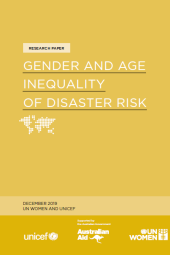Gender and Age Inequality of Disaster Risk, 2019
Summary
This study, conducted globally and in three case study countries (Nepal, Malawi, and Dominica), investigated the link between gender and age inequality and disaster risk. The research reviewed existing literature and datasets, analyzing evidence of differential impacts during specific disasters, such as the earthquake in Nepal (2015), floods and cyclones in Malawi (2015 and 2019), and a hurricane in Dominica (2017). The case studies examined various aspects, including mortality, healthcare, WASH (Water, Sanitation, and Hygiene), livelihoods, education, housing, and migration, while also shedding light on marginalized groups specific to each context, such as widows in Nepal, transgender women in Malawi, and children with albinism in Malawi. The study aimed to amplify the voices and experiences of individuals often overlooked in policy and programming, contributing valuable insights to disaster risk reduction efforts.
The literature review identified instances where inequality resulted in significant differential impacts for women and girls, as well as situations where people of other genders were disproportionately affected, often driven by exposure and context-specific inequalities. However, the data review revealed substantial gaps in globally aggregated quantitative data, with a near absence of sex and age-disaggregated impact data in global disaster databases. For instance, the DesInventar database showed limited sex-disaggregated mortality data across countries. In all case study contexts, disaggregated disaster impact data was limited, emphasizing the diverse ways in which women, children, and marginalized groups can be differentially impacted. The data gaps were found to actively contribute to and reinforce exclusion, making marginalized groups invisible in analysis, policy, and practice across all levels, including census data.
Categories:
Research Paper, GEDSI
Publisher:
UNICEF
Published Year:
2019
